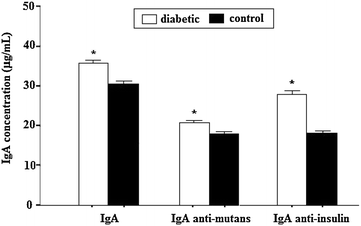Salivary profile in diabetic patients: biochemical and immunological evaluation
- PMID: 26879274
- PMCID: PMC4754859
- DOI: 10.1186/s13104-016-1881-1
Salivary profile in diabetic patients: biochemical and immunological evaluation
Abstract
Background: The aim of this study was to evaluate the biochemical and immunological characteristics of saliva from diabetic patients compared to non-diabetic adults.
Methods: Eighty-eight diabetic adults and 39 non-diabetic adults (control) were included in the study. Glucose, urea, calcium, total protein and amylase were determined by a colorimetric method. The levels of secretory IgA and the IgA anti-Streptococcus mutans and anti-insulin IgA antibodies were measured by enzyme-linked immunosorbent assay (ELISA). Caries status was evaluated using the DMFT index.
Results: Glucose, urea, calcium, anti-S. mutans IgA, total IgA, and anti-insulin IgA were significantly higher in diabetic patients, whereas total protein and amylase levels were lower in these patients. There was no positive correlation between blood and salivary glucose levels in either group. Diabetic patients had a higher DMFT index.
Conclusions: The present study showed for the first time that IgA levels in diabetic patients'saliva, shows correlation with systemic biochemical parameters. Thus the saliva is an useful tool to follow the systemic health status in these patients.
Figures

Similar articles
-
Dental caries increments and related factors in children with type 1 diabetes mellitus.Caries Res. 2008;42(5):354-62. doi: 10.1159/000151582. Epub 2008 Aug 26. Caries Res. 2008. PMID: 18728367
-
Is there association between chronic kidney disease and dental caries? A case-controlled study.Med Oral Patol Oral Cir Bucal. 2019 Mar 1;24(2):e211-e216. doi: 10.4317/medoral.22737. Med Oral Patol Oral Cir Bucal. 2019. PMID: 30818314 Free PMC article.
-
Evaluation of Total Salivary Secretory Immunoglobulin A and Mi/fans-specific SIgA among Children having Dissimilar Caries Status.J Contemp Dent Pract. 2018 Jun 1;19(6):651-655. J Contemp Dent Pract. 2018. PMID: 29959291
-
Correlation among mutans streptococci counts, dental caries, and IgA to Streptococcus mutans in saliva.Braz Oral Res. 2004 Oct-Dec;18(4):350-5. doi: 10.1590/s1806-83242004000400014. Braz Oral Res. 2004. PMID: 16089269
-
Secretory immunity in defense against cariogenic mutans streptococci.Caries Res. 1999;33(1):4-15. doi: 10.1159/000016490. Caries Res. 1999. PMID: 9831775 Review.
Cited by
-
Diabetes as a Risk Factor for Orthopedic Implant Surface Performance: A Retrieval and In Vitro Study.J Bio Tribocorros. 2021 Jun;7(2):51. doi: 10.1007/s40735-021-00486-8. Epub 2021 Feb 22. J Bio Tribocorros. 2021. PMID: 34150468 Free PMC article.
-
Correlation between Salivary Glucose and Blood Glucose and the Implications of Salivary Factors on the Oral Health Status in Type 2 Diabetes Mellitus Patients.J Int Soc Prev Community Dent. 2017 Jan-Feb;7(1):28-33. doi: 10.4103/2231-0762.200703. Epub 2017 Feb 21. J Int Soc Prev Community Dent. 2017. PMID: 28316946 Free PMC article.
-
Exploring Saliva as a Sample for Non-Invasive Glycemic Monitoring in Diabetes: A Scoping Review.Biomedicines. 2025 Mar 14;13(3):713. doi: 10.3390/biomedicines13030713. Biomedicines. 2025. PMID: 40149689 Free PMC article. Review.
-
Novel antibody assessment method for microbial compositional alteration in the oral cavity.Biochem Biophys Rep. 2022 Apr 29;30:101269. doi: 10.1016/j.bbrep.2022.101269. eCollection 2022 Jul. Biochem Biophys Rep. 2022. PMID: 35518198 Free PMC article.
-
Type 1 diabetes, glycemic traits, and risk of dental caries: a Mendelian randomization study.Front Genet. 2023 Oct 10;14:1230113. doi: 10.3389/fgene.2023.1230113. eCollection 2023. Front Genet. 2023. PMID: 37881806 Free PMC article.
References
-
- Moura SAB, Medeiros AMC, Costa FRH, Moraes PH, Oliveira filho SA. Valor diagnóstico da saliva em doenças orais e sistêmicas: uma revisão da literatura. Pesq Bras Odontop Clin Integr. 2007;7:187–194. doi: 10.4034/1519.0501.2007.0072.0014. - DOI
-
- Oliveira Júnior JJ Guerra RNM. Biomarcadores imunológicos da saliva. RevCiencSaude (São Luís) 2010;12:136–145.
Publication types
MeSH terms
Substances
LinkOut - more resources
Full Text Sources
Other Literature Sources
Medical
Miscellaneous

